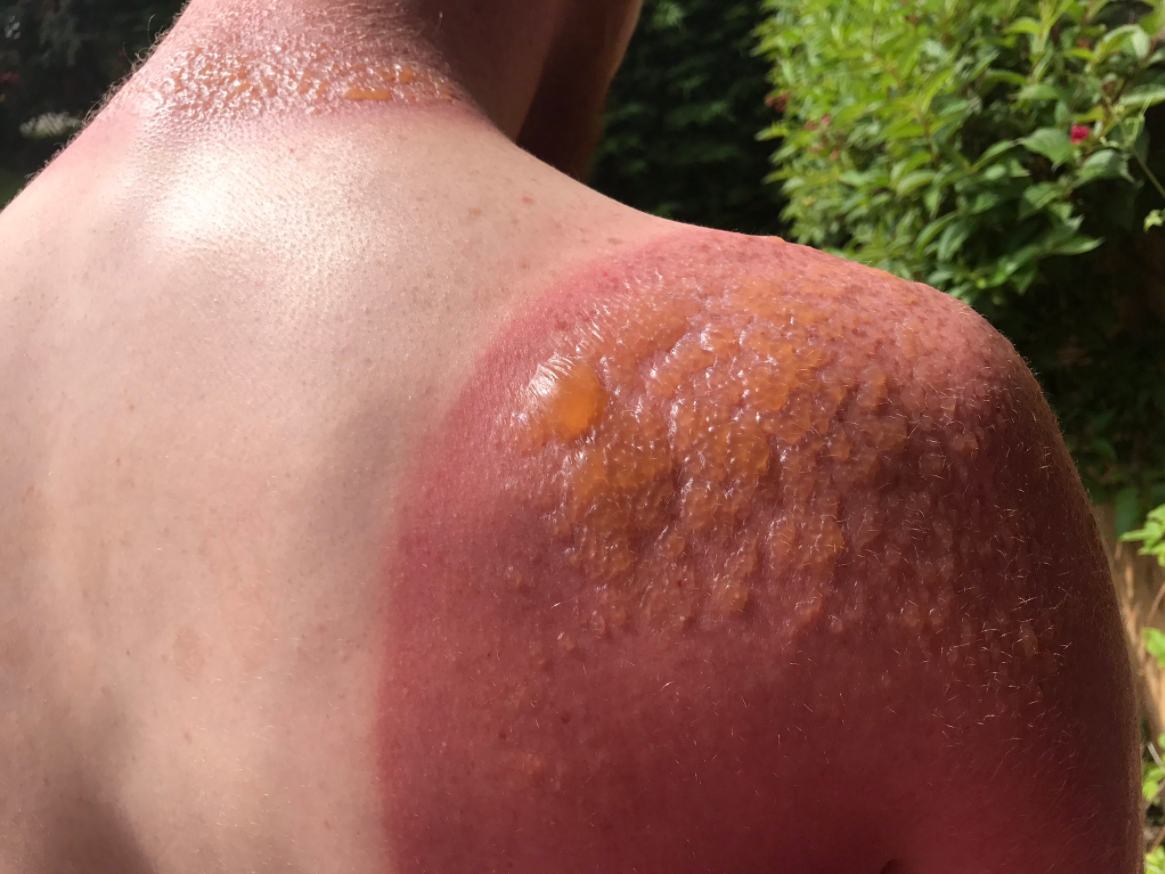Sunburns are irritating and can be downright painful – just ask Greg Binnie from Scotland whose skin was left with second-degree burns after he spent an afternoon outside sans sunscreen.

According to the BBC, the 20-year-old was working outside mowing lawns for seven hours last Saturday when he first felt a burn coming on.
READ MORE: Sun safety: Reducing your risk of health issues from heat stroke and melanoma
“The weather was forecast to be quite nice but nothing out of the ordinary,” he told BBC Newsbeat. “I did feel hot during the day but just assumed it was because of how much work I was doing. I could feel my skin was a bit tender but it wasn’t until my mum and dad did point out the red colour on my skin was a bit intense.”
Despite the obvious burn, the Edinburgh, Scotland, native went back to work the next day, where he spent even more time in the sun. It wasn’t until Sunday night that he noticed his skin had gotten worse and started blistering.
Binnie, who is fair skinned, says he does tend to burn but this was the worst he’s ever experienced.
“I guess when you’re on holiday you use sunscreen but it’s not something you think about when you’re at home,” Binnie said. “Especially living in Scotland where you don’t get this weather often.”
He then posted the photos to social media to warn others about the dangers of sun exposure and sunburns, he told Refinery29.
Binnie was forced to take a few days off from work to recover. In the meantime, he continuously applies Sundocrem and aloe vera spray every couple of hours to help his burns.
According to the government of Canada, sun exposure can be both beneficial and harmful, depending on how long one has been exposed to the ultraviolet (UV) radiation
Sun exposure provides your body with vitamin D and can help kill germs. It can also be used as a treatment for some skin conditions.
READ MORE: Where you live could affect your risk of skin cancer: StatsCan
However, overexposure to UV radiation can leave you with sunburns, premature skin aging and put you at risk for skin cancer.
- Invasive strep: ‘Don’t wait’ to seek care, N.S. woman warns on long road to recovery
- Canadian man dies during Texas Ironman event. His widow wants answers as to why
- ‘Super lice’ are becoming more resistant to chemical shampoos. What to use instead
- ‘Sciatica was gone’: hospital performs robot-assisted spinal surgery in Canadian first
“Skin damage by the sun is cumulative,” the website says. “This means that long-term, daily exposure to sunlight adds up. UV exposure causes damage in the DNA of your skin cells. Damaged cells do repair themselves. If, however, the damage is too severe to be repaired, you can get skin cancer.”
The website offers several tips on sun safety:
- Cover up: Wear light-coloured clothing, long-sleeved shirts, pants and a hat made from breathable fabric.
- Limit your time in the sun: Stay out of the sun and heat between 11 a.m. and 4 p.m. when the sun is the strongest. Note that when your shadow is shorter than you, the sun is at its strongest. Look for places with shade and always bring an umbrella to the beach.
- Use sunscreen: Put sunscreen on when the UV index is three or higher.
- Drink plenty of cool liquids (especially water) before you feel thirsty: Stay cool and hydrated to avoid heat illness.
- Avoid using tanning beds: If you do use them, understand the risks and know how to protect yourself.
Knowing how to identify which type of burn you’re suffering from can be difficult.
According to the University of Rochester Medical Center, there are four classifications of general burns:
First-degree (superficial) burns: This type of burn only affects the epidermis, or the outer layer of skin. The site of the burn appears red, dry and without blisters, and can be painful. This is often the case with mild sunburns. First-degree burns usually heal within seven to 10 days without scarring, Healthline adds. To treat, soak the burn in cool water and soothe the skin with aloe vera or lidocaine (an anesthetic). Do not put ice to the affected area or use cotton balls as that may make the damage worse.
Second-degree (partial thickness) burns: When the epidermis and part of the dermis layer of the skin is burned. The site appears red, blistered, and maybe be swollen and painful. To treat, keep the area clean and bandage it properly to prevent infection, Healthline says. You can also run the burned area under cool water. Some of these burns may take up to three weeks to heal.
Third-degree (full thickness) burns: This burn destroys the epidermis and dermis and may even go into the subcutaneous tissue. The site appears to be white or charred. You may also see blisters that do not develop. According to Healthline, without surgery, these burns often cause scarring. Don’t attempt to self-treat a third-degree burn, instead visit a physician immediately.
Fourth-degree burns: This type of burn damages the underlying bones, muscles and tendons. There is no feeling to the area as the nerve endings are destroyed. Only physicians can treat this degree of burn.
According to the Canadian Cancer Society, melanoma – also known as skin cancer – is being diagnosed more often in both men and women in Canada over the past several decades.
Between 1992 and 2013, the incidence rates rose by 2.1 per cent per year in men and 2 per cent in women.
About one-third of all new cases of cancer in Canada are skin cancers, the government of Canada reports.






Comments